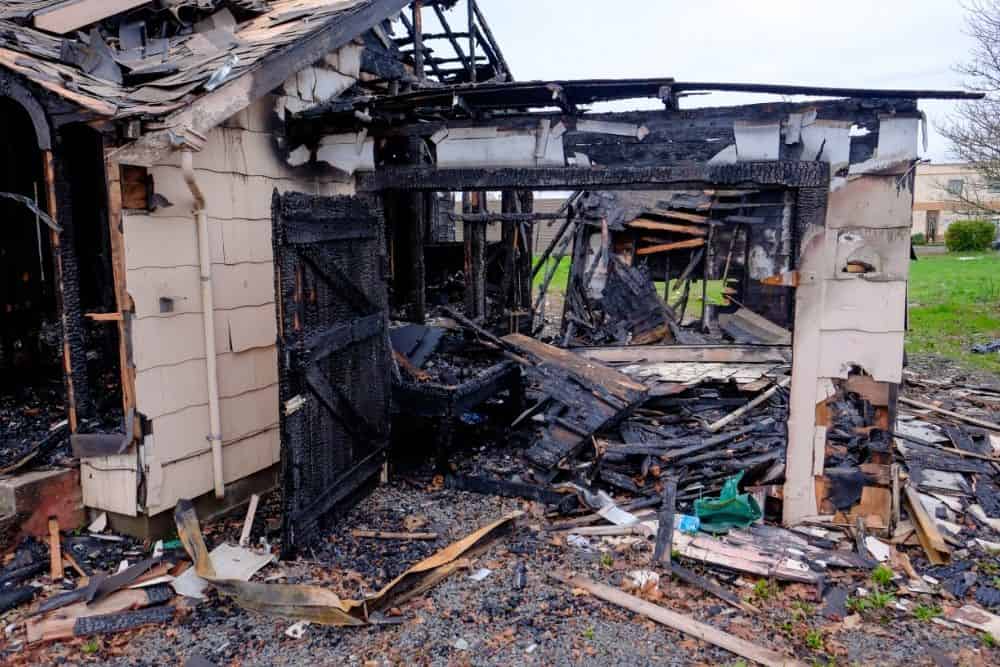
Not too long ago, I got an early morning call about a fire in a local business that we insure. I quickly got dressed and headed to the scene.
After talking with others there that morning, I discovered that the fire source was some rags. Without giving it a second thought, someone had left a little pile of oily rags in a back room. Spontaneously, the rags caught fire which then spread to some boxes nearby.
A few days later, I was telling a friend about the fire. He chimed in by sharing that he knew someone who had also experienced a fire in his garage due to the same thing – rags soiled with linseed oil left in a pile.
I hadn’t given much thought before to the dangers of leaving oily rags (or rags wet with cleaning products) in a pile on the garage floor. And I certainly hadn’t thought about them spontaneously catching fire.
This started me thinking about you, our clients. I wondered how many of you knew about the dangers of cleaning rags and spontaneous combustion.
It may not seem like a big problem, but according to the National Fire Protection Association (NFPA), an estimated 14,070 fires occur annually from spontaneous combustion. That’s a lot of fires!
And any fire in a home or a workplace can be crippling! Fires often lead to displacement, loss of income, and, most tragically, loss of life.
So, before you end up with a pile of oily rags from staining your decks, porch furniture, or floors, OR before you throw a bunch of wet cleaning rags in the trash can, I wanted to share with you what I’ve learned about spontaneous combustion.
As part of the Baily Insurance family, we want you to know how you can prevent this kind of tragedy from happening to you and those you love.
So let me share with you:
- What kinds of projects and products are associated with spontaneous combustion?
- What causes spontaneous combustion?
- What can you do to prevent these accidents from happening?
What kinds of projects and substances are associated with spontaneous combustion?
While spontaneous combustion is known to occur in a pile of oily rags, that’s not the only situation in which this phenomenon happens.
Here are other situations where this may occur.
Farms and Lawn Care
If you’re a farmer, you probably already know about the possibility of a pile of wet hay catching fire all on its own. But, compost piles, piles of leaves and grass, mulch piles, and manure piles also have the potential to self-combust.
Cleaning Products
A host of oil-based cleaning products are associated with spontaneous combustion. These include paint thinners, cottonseed oil, linseed oil, oil-based paints, teak oil, varnish, and polyurethane.
Often people use rags to apply these products when staining and finishing wood.
Paint strippers and thinners are not oil-based and are not associated with spontaneous combustion.
Auto Oils and Gasoline
While not as likely to spontaneously catch fire, rags that soaked in engine oil or gasoline can self-combust. If you have a gasoline spill in your garage or workshop and use rags to clean it up, those rags left in a pile could spontaneously combust.
Cooking Oils
In restaurants, rags that are soiled with cooking oils have been known to catch fire spontaneously. These rags must be appropriately stored to prevent a fire.
In the home, cooking oils like olive oil or canola oil are not likely to spontaneously combust if left in a pile. The most significant danger with these oils is in the dryer.
If you have a dish towel or cloth that you use to clean up a cooking oil spill and then wash the towel or material, the water actually locks the oils into the fabric.
Then, when you put the cloth in the dryer, the heat in the dryer can lead to the towel or cloth catching fire.
What causes soiled rags and materials to self-combust?
When oily rags, piles of hay, or compost piles interact with the air around them, the oils or wet vegetation reacts with the oxygen in the air. This is a process called oxidation.
Oxidation gives off heat.
So when the rags or hay are oxidizing, they are slowly giving off heat. And if the temperature of a pile of oily rags reaches the combustion point, the pile of rags will catch fire spontaneously.
It’s the same with piles of hay, manure, or compost. If you’ve ever worked with these substances, you may have noticed that the middle of the pile can be especially warm, evidence of the oxidation process.
How can you prevent oily rags or hay piles from spontaneous combustion?
While all of the substances mentioned above are associated with spontaneous combustion, fires that start from piles of oily rags are the most common cause of spontaneous combustion structure fires. And garages are the most common area where these kinds of fires begin.
So this leads us to the most crucial part of our discussion. What practical steps can you take to protect yourself from a spontaneous fire?
#1 At home, never store oil-soaked or chemical-soaked rags in a pile. Spread out the rags outside on concrete securely until the oil evaporates. You’ll know the oil has evaporated once the rags become stiff. Don’t dry the rags in direct sunlight! After evaporation, you can wash the rags for reuse.
#2 In a work setting, dispose of oily rags in an OSHA-approved container and have an industrial cleaning company pick them up.
#3 Make sure hay is completely dry before you bale it and store it. Also, make sure your barn or storage facility is properly ventilated.
#4 Keep piles of compost, leaves, grass clippings, mulch, or manure away from any structures like your home, garage, barn, or shed. Make sure the piles are small so that moving air can help dissipate heat. Also, turning your compost, mulch, or manure pile every two weeks can help prevent the heat from building up in the middle of the pile.
#5 Here is one other option for storing oily rags. Thoroughly dry the rags out. Then, place them in a metal container – like an old paint can. Fill the can with water and detergent designed to break down oils. Seal it. You can dispose of the rags at a hazardous waste collection event.
Are you interested in learning about other safety topics to keep your family, home, or business safe?
One of our primary goals at Baily Insurance Agency is to educate our clients on actions they can take to protect the things they value most – their families, homes, and businesses.
One way we work toward this goal is by providing our clients with educational opportunities like blog articles or safety videos. We also like to pass along safety tips and information that our insurance carriers provide for us.
If you would like to receive other blog articles or materials related to safety, we’d be happy to send them directly to your inbox.
Just let us know by filling out the form below. When you fill out this form, you can expect a monthly blog article or helpful information from one of our insurance partners to help you put practices in place to protect what matters most to you.
Thanks for visiting our blog! We pray that you enjoy a safe and healthy spring!
Monthly Safety Articles
For clients who want to receive a monthly safety email directly in their inbox!

